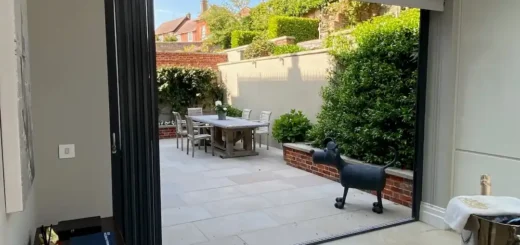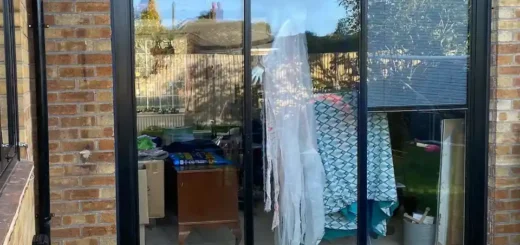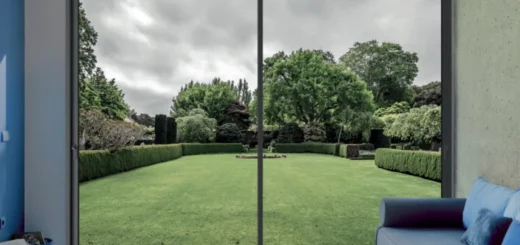Aluminium Slide and Fold Doors: Buyer’s Guide
Table of Contents
How Aluminium Slide and Fold Doors Work
Aluminium slide and fold doors (also known as aluminium slide and turn doors, aluminium slide and pivot doors, or aluminium slide and stack doors) combine the best features of sliding doors and bifolds, letting you move panels along a track before folding them to one side. The panels glide smoothly on rollers before pivoting outwards, creating wide, unobstructed openings when fully retracted.
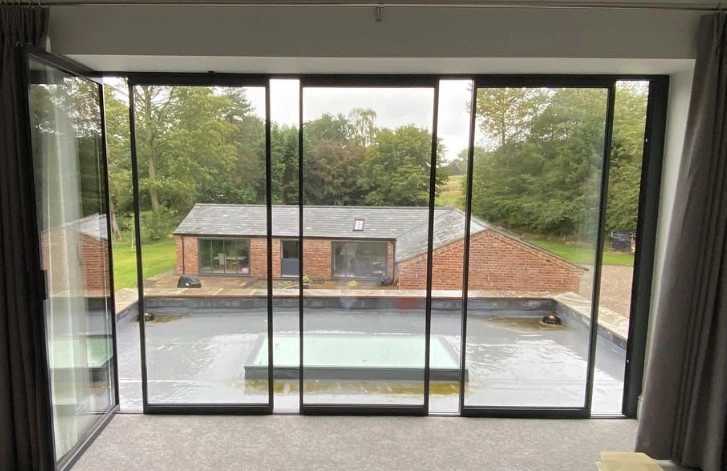
Opening Mechanism
Moving aluminium slide and fold doors starts with unlocking the main traffic door, which acts like a normal door for everyday use. The remaining panels stay locked in place until you want to open the full width. Pushing the first panel creates momentum along the track, with each panel sliding until it reaches a specific point. At this spot, the panel smoothly pivots outward, guided by the hardware system built into the top and bottom of the frame.
Panel Configurations and Stack Widths
Modern glass doors need careful planning when it comes to panel layouts. A three-panel system takes up less space when open than you might expect – typically the width of a single panel plus a small gap. For five panels, the stack sits at roughly one and a half times a single panel’s width. The panels fold flat against each other rather than creating a concertina shape, which helps reduce the space needed.
Track Systems
A single track carries both the sliding and folding movement, with precision-engineered rollers supporting each panel’s weight. The track itself contains special areas where panels can pivot without jamming or scratching. Deeper tracks provide more stability for taller or wider panels, while shallower options work well for standard-sized doors.
The hardware does most of the work – steel rollers carry the weight while guide pins control the movement path. These components, precisely fitted at both the top and bottom of each panel, determine exactly where each door panel stops to pivot. This carefully planned system prevents panels from moving in unexpected ways or putting stress on the frames.
Benefits of Aluminium for Slide and Fold Doors
The structural properties of aluminium make it an ideal material for slide and fold doors. Its high strength relative to weight allows for slimmer frames that still support large glass panels, while resisting the daily wear of sliding and pivoting movements.
Frame Strength
Aluminium slide and fold doors remain stable and true over many years of use. The metal’s natural rigidity prevents warping or sagging, common issues with other materials that can jam the sliding mechanism or stop panels from folding properly. Powder coated aluminium doors add an extra layer of durability, protecting the frames from scratches and weathering while maintaining their appearance.
Modern aluminium framed doors achieve impressive spans – up to 3 metres high in many cases – without needing bulky frames. The material’s inherent strength supports triple-glazed units weighing up to 100kg per panel. Despite these hefty glass weights, the frames stay slim, typically measuring between 45mm and 70mm in visible width.
Advanced alloys used in today’s aluminium slide and fold doors provide exceptional structural integrity. The frames resist twisting forces created by wind pressure, while supporting the constant weight of glass panels through thousands of opening and closing cycles. This strength comes from careful material selection and precise manufacturing processes that create strong yet lightweight profiles.
Weather Performance
British weather demands robust door systems that keep rain, wind and cold at bay. The stability of aluminium prevents the gaps and misalignment that often occur with other materials. Special thermal breaks – strips of non-metal material – separate the inner and outer frame sections, blocking heat transfer through the metal.
Aluminium slide and turn doors perform well in coastal areas too, where salt-laden air can damage less suitable materials. The powder coating process creates a tough barrier against corrosion, while gaskets and brush seals stay flexible and effective year after year. When properly maintained, these doors maintain smooth operation regardless of temperature changes or exposure to harsh conditions.
Thermal Efficiency
Modern aluminium frames contain multiple chambers and sophisticated thermal break technology. These features trap air and block heat movement through the frame, improving the overall insulation of the door system. The frame design works with high-performance glass units to reduce heat loss in winter and solar gain during summer.
Thermal imaging tests show how effectively these systems retain heat. The latest aluminium slide and fold doors achieve U-values below 1.4 W/m²K when fitted with triple glazing. This performance matches or improves upon traditional window materials while offering much larger glass areas and flexible opening options.
The frame’s thermal performance remains consistent over time, unlike some materials that can absorb moisture and lose their insulating properties. Smart frame design channels any water that does reach the internal spaces straight out through drainage paths, preventing build-up that could reduce thermal efficiency or cause long-term damage.
Aluminium Slide and Fold Doors vs Other Door Types
Different door systems suit different spaces and needs. Aluminium slide and fold doors offer unique advantages over traditional sliding doors and bifolds, particularly in terms of opening width and operational flexibility.
Space Requirements
Standard bifold doors need a wide sweep area when open, often limiting furniture placement or patio space. In contrast, aluminium slide and fold doors use a combined sliding-folding action that requires less projection space. The panels first slide along the track before folding, reducing the area needed for operation by up to 40% compared to pure bifolds.
When fully retracted, the door panels stack neatly against the jamb. A typical four-panel configuration needs only about 400mm of stacking space, while six panels require roughly 600mm. This efficient use of space proves particularly valuable in smaller gardens or when working with limited wall space for panel stacking.
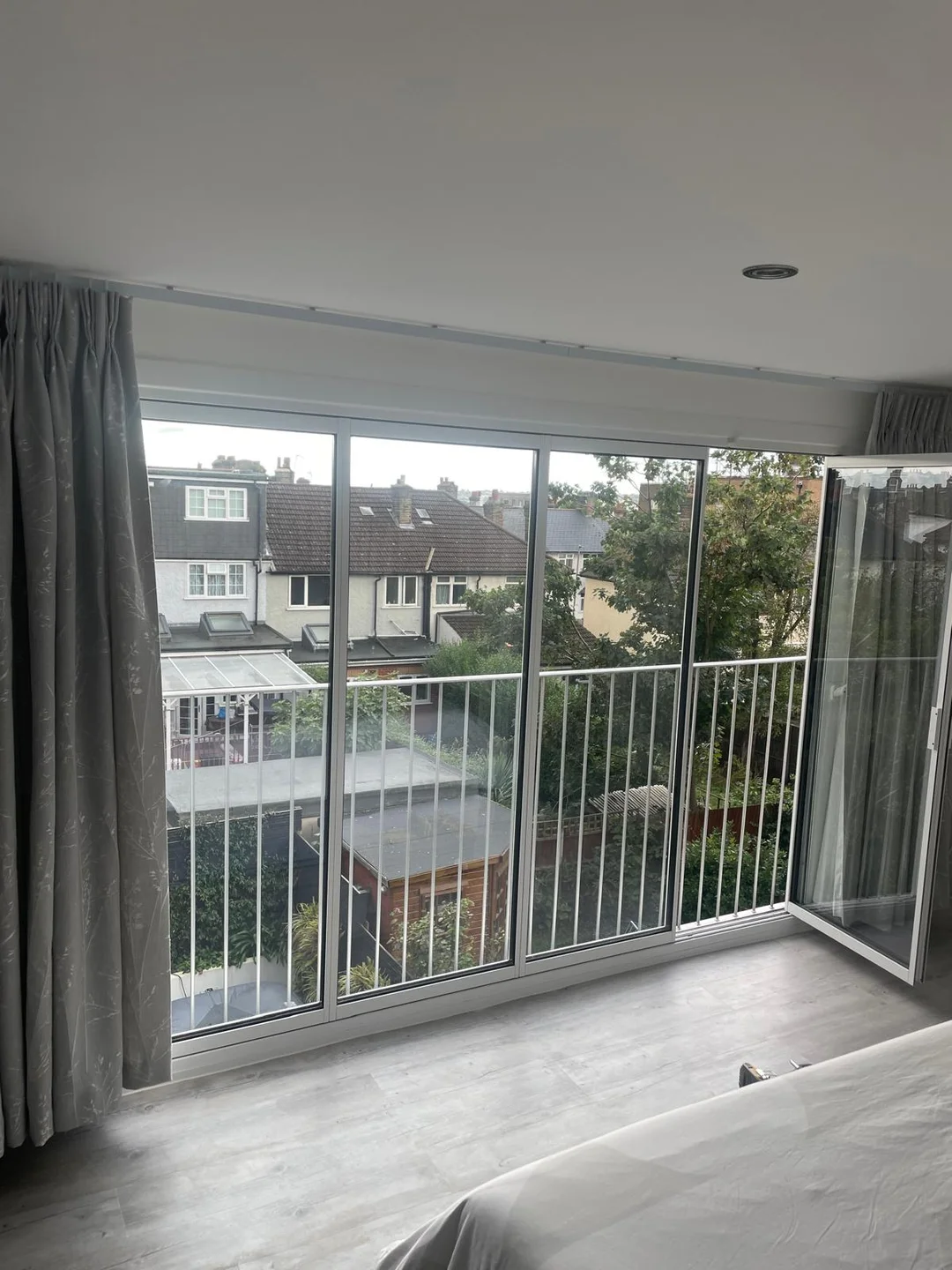
Glass Area
Exterior glass doors come in many configurations, but aluminium slide and fold doors stand out for their slim sightlines. The frames measure just 45-70mm in visible width, compared to typical sliding door frames at 65-100mm. This difference adds up across multiple panels – a four-metre-wide opening can gain nearly half a square metre of glass area simply by choosing slimmer frames.
The structural strength of aluminium allows for larger individual glass panels than many other systems. While standard sliding doors often limit panel widths to around 1.5 metres, aluminium slide and fold doors can accommodate panels up to 1.8 metres wide. This flexibility lets you choose fewer, wider panels for better views when the doors are closed.
Frame thickness directly impacts the overall look of your doors. Deeper frames provide more strength but can appear bulky, especially in smaller openings. The optimal frame depth varies based on door height and panel weight – taller doors need deeper profiles to prevent bowing, while shorter doors can use slimmer frames without compromising stability.
Opening Flexibility
Traditional sliding doors move only horizontally, limiting your options for creating wide openings. Aluminium slide and fold doors combine sliding and folding movements to offer more versatile opening configurations. You might slide just one or two panels for quick garden access, or fold all panels back for maximum opening width.
The traffic door – usually the first panel – works like a regular hinged door for everyday use. This means you don’t need to move multiple panels just to pop outside. When you want a wider opening, additional panels slide and fold in sequence, letting you adjust the aperture to suit different situations or weather conditions.
Multi-point locking systems secure each panel independently. This security feature allows partial opening while keeping other panels locked in place. The locking points engage with the frame at multiple heights, preventing forced entry attempts and ensuring the doors stay weathertight when closed.
The tracking system guides panels smoothly through their sliding and folding movements. Top-hung designs carry the panel weight from above, reducing track wear and making the system easier to clean. Bottom-running options provide more stability for very tall or wide panels, though they need regular track cleaning to maintain smooth operation.
Choosing Door Thresholds for Aluminium Slide and Fold Doors
The threshold design makes a big difference to how aluminium slide and fold doors work in daily use. Your choice of threshold balances weather protection, accessibility, and visual appeal, with options ranging from completely flat to raised profiles.
Flush Thresholds
Flush threshold options create a completely level floor between inside and outside spaces. The track sits recessed into the floor, with drainage channels hidden beneath removable covers. This design works well for sheltered locations or where the outside paving slopes away from the doors.
Proper installation becomes especially important with flush thresholds. The surrounding floor levels need precise adjustment to direct water away from the opening. Many aluminium slide and fold doors with flush thresholds include hidden drainage channels that collect any water that reaches the track, preventing it from flowing inside.
While flat thresholds look stunning and remove trip hazards, they require careful planning. The floor structure needs sufficient depth to accommodate the recessed track – typically 50mm to 75mm depending on the system. Heating pipes, underfloor insulation, and other services might need rerouting to make space for the threshold detail.
Low Profile Options
A small step of 15mm to 30mm provides improved weather protection while maintaining good accessibility. These mid-height thresholds strike a practical balance, keeping out wind-driven rain without creating a major obstacle. The raised profile also simplifies installation since less floor depth is needed for the track.
The thermal performance improves with low-profile thresholds too. The slight raise creates space for better insulation below the track, reducing heat loss through the floor junction. This matters particularly in new extensions where building regulations demand good thermal performance across all elements.
Standard Thresholds
Full-height thresholds measuring 40mm to 60mm provide maximum weather protection. These robust profiles work well in exposed locations or coastal areas where driving rain poses regular challenges. The extra height allows for sophisticated drainage and sealing systems within the threshold itself.
Room by Room Guide to Aluminium Slide and Fold Doors
Different rooms present unique requirements for door systems. The way you use each space shapes decisions about panel sizes, opening configurations, and threshold types.
Kitchen Extensions
Modern kitchen extensions often feature large glass walls that open fully to patios and gardens. Aluminium slide and fold doors work particularly well here, as their slim frames let in plenty of natural light while cooking or dining. The traffic door provides quick access for bringing food outside, while the ability to open the full width proves invaluable when hosting larger gatherings.
Kitchen extension doors need careful planning around worktops and islands. The stacking area for door panels should avoid blocking key work zones or walking routes. A five-panel configuration spanning six metres typically needs about 500mm of stacking space – roughly the depth of a standard worktop. This measurement helps determine optimal kitchen layouts that work well whether the doors are open or closed.
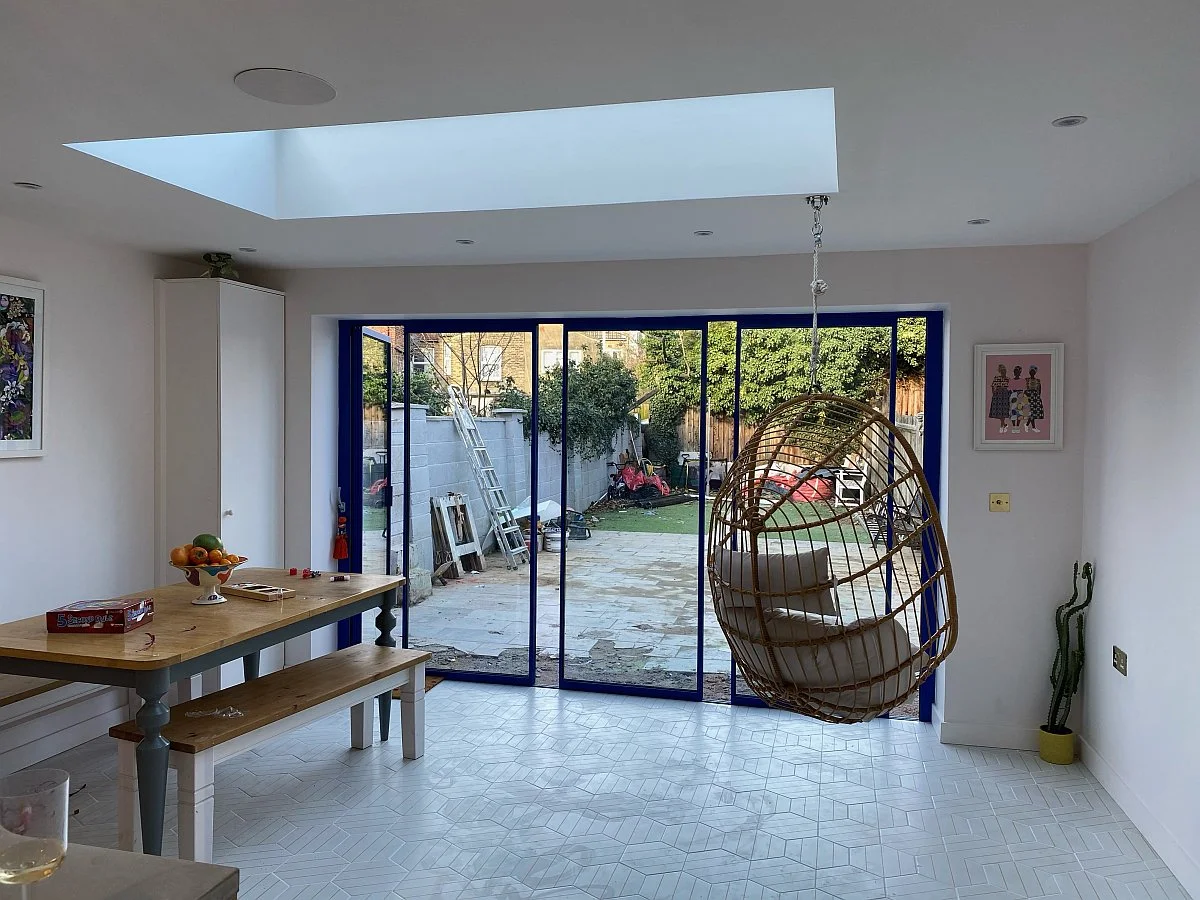
The kitchen environment demands special attention to ventilation. Opening just one or two panels of aluminium slide and fold doors provides targeted airflow while cooking, without creating unwanted drafts across food preparation areas. Panel configurations with a slave door next to the main traffic door offer extra flexibility for quick ventilation.
Steam and cooking odours can leave deposits on glass and frames over time. Powder-coated aluminium proves easy to wipe clean, while the sliding mechanism stays protected from grease and grime. Regular cleaning of tracks and runners prevents build-up that might impede smooth operation.
Living Spaces
Living rooms benefit from the ability to adjust opening widths according to weather and occasion. The panels of aluminium slide and fold doors stack neatly against walls, preserving valuable floor space for furniture arrangement. This flexibility lets you maintain clear views through closed panels during poor weather, then open up completely on warm days.
Sunlight control becomes important in south-facing living spaces. The frame design can accommodate double or triple glazing with solar control coatings. These glass options reduce glare and heat gain without compromising the views or natural light that make these doors so appealing.
The living room often serves multiple purposes throughout the day. Panel configurations should reflect these varying needs – perhaps including a traffic door near the seating area for easy access, with additional panels that open towards garden features or entertainment spaces.
Garden Rooms
Year-round garden rooms need robust glazing systems that handle temperature extremes. The thermal breaks in aluminium frames prevent condensation forming during cold spells, while maintaining comfortable internal temperatures. This insulating performance helps reduce heating costs and extends the usability of garden rooms through winter months.
The durability of aluminium proves valuable in garden room settings where doors might see frequent use. The hardware systems resist wear from regular opening and closing, maintaining smooth operation without requiring frequent adjustment. Proper maintenance simply involves keeping tracks clean and occasionally checking seal condition.
Multi-panel configurations let you position furniture flexibly in garden rooms. Rather than planning around a fixed opening point, you can arrange seating and tables knowing that different sections of the doors can open as needed. This adaptability helps garden rooms serve various purposes throughout the year.
Pool Houses
Swimming pool environments create unique challenges for door systems. The chlorinated atmosphere can corrode some materials, but aluminium slide and fold doors resist this chemical exposure effectively. The powder coating provides an additional barrier against moisture and pool chemicals.
Ventilation control becomes essential around indoor pools. The ability to open specific panels helps manage humidity levels while maintaining comfortable temperatures. This selective opening also helps prevent excessive heat loss during colder months when full width access isn’t needed.
Safety features take priority in pool areas. Low-profile thresholds reduce trip hazards, especially important when surfaces might be wet. The locking mechanisms should be easily operable with wet hands but secure enough to prevent unsupervised pool access.
The tracking systems need extra attention in pool environments. Regular cleaning prevents salt, chlorine, or mineral deposits from building up in the runners. Most systems include drainage channels that help prevent standing water around the threshold – particularly important for pool house installations.
About SunSeeker Doors
With over 20 years of experience, SunSeeker Doors remains at the forefront of door design with our quality-tested patio doors and related products, including the bespoke UltraSlim aluminium slide and pivot door system, Frameless Glass Doors, and Slimline Sliding Glass Doors. All of our doors are suitable for both internal and external use.
To request a free quotation, please use our online form. You may also contact 01582 492730, or email info@sunseekerdoors.co.uk if you have any questions.


